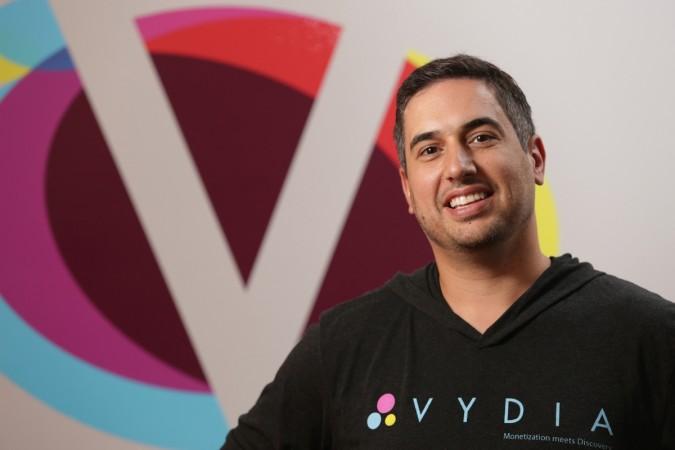
According to the Global Music Report 2016, music streaming and digital downloads have officially surpassed the sale of physical copies as the main source of revenue for recorded music.
Although this should spark a cause for celebrations as the total revenue of the music industry grew by 3.2 per cent, streaming services such as Spotify and YouTube have faced severe criticism from the likes of Metallica, Taylor Swift and Thom Yorke, as a significant value gap in revenue has been noted by industry experts.
In an exclusive interview, industry insider Roy LaManna, the CEO of Vydia, a music video distribution platform, and Trendsetter Marketing, a public relations company which boasts of a roster that includes artistes such as Ariana Grande, Justin Bieber and Major Lazer, explains to International Business Times, India why streaming can sustain the music industry in the future and how solving a metadata problem can allow artistes to make money out of their music.
International Business Times: Streaming has recently surpassed downloads as the main source of revenue in music. Do you think it can sustain the industry?
Roy LaManna: Streaming can certainly sustain the music industry. Right now, it is the number one revenue source and is already an industry. It's happening right now. I do think we are going to start to see changes in the infrastructure around the artiste to increase profitability. There is no reason to have the same infrastructure around an artiste or a band that you would have had like when you were selling CDs and we are going to continue to see changes to the ever-growing movement of streaming.
IBT: You have said that a back end metadata problem is responsible for artistes not making money through streaming. Is there a solution?
LaManna: The biggest problem is when you are talking about specifically YouTube, we are talking about three different kinds of copyright controlled by multiple owners and multiple territories, none of which is communicating efficiently with each other. If two people say they own something on the back end, no one gets paid and no one is generating revenue. This is going to be a problem that will continuously get worse as time goes on and things continue to get more complicated with songwriters, publishers, producers, etc.
IBT: How can solving a metadata problem help artistes earn money from streaming?
LaManna: When something streams, that site needs to have a policy associated with it. If it's YouTube, for instance, they need to know when that copyright shows up whether it's a sound recording, an audio file or a video file and that site needs to know who to send the money to. By having clean metadata, these sites will know who to pay and where to send the money automatically. If that doesn't happen, the revenue is not paid retroactively.
Also read: Music streaming overtakes CDs as main source of industry revenue, reports say
IBT: How is Vydia helping independent artistes?
LaManna: Vydia is helping independent artistes by making something that is extremely complicated, very simple. Artistes don't think in terms of metadata, they just think they want to publish their content to a site or many sites and get exposure. Most artists utilise our tool to publish, schedule and distribute their videos to multiple platforms. Any of the back end conflicts our platform will detect and if we can't solve it automatically, we provide specific instructions to the artiste to help resolve the issue and make sure the asset monetises correctly.
IBT: Vydia offers to upload an artiste's video on Vevo, which is not available throughout the world. So how would Vydia benefit artistes living outside the U.S., Canada and the U.K.?
LaManna: Vevo is not available throughout the world but it is available in most countries and it's growing every day. One thing that is growing for artistes outside the U.S. is that YouTube and Vevo are the way through which a lot of other countries consume music. There are no radio stations, so if you are a world artiste from Africa or a Latin artiste from Mexico, they don't have the infrastructure that we have in the United States. A lot of Latin artistes put their music onto YouTube and Vevo through Vydia where their fans can consume their music here in the States. The United States has a big Latin and Mexican population and if you are a Mexican artiste, they are finding your content in the U.S. by turning on YouTube.
IBT: Let's take India for example. The country has a lot of extremely talented independent musicians. How do we enable them to earn as much as an artiste living in the U.S. or U.K.?
LaManna: The great thing about the internet is that it levels all playing fields. When physicals ruled the music world, it was very difficult for fans of Indian music in the U.S. to find imported music. Now, this music is becoming more readily available on streaming sites like YouTube. The great thing about it is that an artiste in India who publishes their content through Vydia; they're getting the same CPMs (Cost Per Thousand Views) as an American artiste. The revenue generated from streaming sites is determined where the fan views the music, not where the artiste is located.
IBT: How can an independent artiste make money through streaming when they are just starting off?
LaManna: This is a difficult question because it's different for each artiste. They're going to start making money right away but it's all going to depend on how many views they are getting and where the views are originating from across all of their content. We see independent artistes who publish a lot of content. Content is king, and if you are proficient in creating a lot of audio and video content, you can start seeing a return investment and money coming in the door within 30-60 days. This is much faster than it was when people would sell CDs and get paid a year and a half later.
IBT: Streaming services like Spotify and Apple music do offer a small amount of royalty to the artiste. While that can never be a major issue for established artistes (who earn well through live gigs), what is the alternative for independent artistes who are just starting off?
LaManna: Independent artistes have the luxury very early on of not having other people to pay other than themselves. So if an independent artiste can be on multiple streaming services and create a lot of content, they can generate a couple of thousand dollars a month. If you are paying no one but yourself, that's good money. What most people don't realise is the moment you introduce a label, manager, agent, etc. you need to earn significantly more money to yield the same return you were seeing when you were by yourself.
IBT: On YouTube, an artiste's income is totally dependent on ad sales on the streaming site. Also, users upload music without proper permissions, hurting artistes' income. What steps would you recommend for an artiste in this case?
LaManna: Artistes need to understand that every time they create a piece of audio and/or video, it is intellectual property. When these assets are uploaded, the official and user-generated instances of their IP need to be monetised. Now if YouTube is not paying for their user-generated content it's because they don't have a policy associated with that copyright. Simply uploading to YouTube and turning on monetisation doesn't do it. You need a company like ours to tell YouTube, and other sites, that you own this content and that you need to get paid for it anytime any of their users upload it to their platform.
IBT: Metallica recently slammed YouTube's business model and said that it is not sustainable for musicians. How do you react to that?
LaManna: I'm not sure Metallica is truly representative of the average musician. You have to remember, that it was them who ultimately took on Napster and although they won in court, they ultimately lost. I say that because many musicians who made a lot of money in the 2000s and earlier didn't want technology to change. However, it does change, and you need to get ahead of it, not try and stop it.
IBT: IFPI CEO Frances Moore recently talked about a value gap in the music industry revenue in the Global Music Report 2016. What steps can be taken in the future to overcome this gap?
LaManna: Frances defines the value gap as the space between music consumption and music revenues. The thing the IFPI doesn't take into consideration is that there's more music now than there was 15 years ago and you had to be signed to a label in order to get your content out there. Now, the barrier of entry is much lower, meaning that people don't have to find music that is only available through major labels. The report also mentions that more revenue needs to be generated for the labels and the artistes. In my opinion, revenue only needs to be given to the artiste — and the label is only necessary in the chain if it creates a better benefit to the artiste.
IBT: Lack of awareness is a major issue for artistes not making money. How can that be overcome?
LaManna: One of the great things about YouTube and other streaming platforms is that anyone can be a musician and create content. You are only limited by your artistic ability. Typically, if you feel like you are not getting that much exposure, my advice is to create as much content as possible and keep honing your craft. I have very rarely seen something amazing that goes unnoticed and when people are creating really good songs and really cool videos, they have a way of becoming viral and people will watch it. I think that's the major key. A lot of people focus on how they can grow their social media or how to get more views but I think it all starts with the first step — create really amazing, compelling content.
IBT: Getting exposure is also a major problem faced by an independent artiste. How can this be solved?
LaManna: If I started a career as an independent artiste today, I would have the same access to the promotional channels that any major artiste would. I am uploading to YouTube, I am uploading to Vevo, I am on the same platform as every major artiste and I can do that by paying $20 a year and it all comes down to creating compelling content.
IBT: How should independent artistes/bands overcome the lack of money to spare for promotions?
LaManna: I also run a company called Trendsetter Marketing where for the last 15 years we have done music video marketing and I will be the first one to say, we are working with some of the biggest artistes in the world, everything we do is nothing someone cannot do on their own. It is a matter of really being adamant and making sure you are persistent, that you are trying to find a mutually beneficial situation between you and the person that you are pitching. I got my start working with Fall Out Boy very early on with no experience when the band was unknown and it was a matter of finding the right person to talk to and constantly opening doors and doing what it takes to make it happen.
IBT: How should musicians deal with piracy, which is rampant among listeners?
LaManna: I think consumers would rather get their content from legitimate ways rather than pirating. Most people I know were bootlegging songs, even people working in the music industry, when Limewire and Napster first came out. Most people now are always listening to Spotify or Apple Music or YouTube — these are all legitimate ways to consume music. Most people want to consume content in a legitimate way. However, if you force them to buy a CD because you make your music unavailable on these streaming platforms, they are going to find an alternative method to get it, which will include illegal downloading. I think the best way to combat piracy is to make the legitimate way to consume music so convenient that it just doesn't make sense to try and find it any other way. It is also a value proposition. Streaming services are of a tremendous value, you are getting your content over multiple devices in the cloud for the price that is equivalent to buying a coffee at Starbucks. Why do you want to take a chance to download an audio file that could sound like crap to save a couple of dollars and have it live on an iPod or iPhone you probably won't even have in two years?



![Gaurav Khanna's birthday: BB 19 winner gets emotional as young fan gifts him bouquet at Siddhivinayak Temple [Reactions] Gaurav Khanna's birthday: BB 19 winner gets emotional as young fan gifts him bouquet at Siddhivinayak Temple [Reactions]](https://data1.ibtimes.co.in/en/full/825735/gaurav-khannas-birthday-bb-19-winner-gets-emotional-young-fan-gifts-him-bouquet-siddhivinayak.jpg?w=220&h=135&l=50&t=40)




![Gaurav Khanna's birthday: BB 19 winner gets emotional as young fan gifts him bouquet at Siddhivinayak Temple [Reactions]](https://data1.ibtimes.co.in/en/full/825735/gaurav-khannas-birthday-bb-19-winner-gets-emotional-young-fan-gifts-him-bouquet-siddhivinayak.jpg?w=220&h=138)


![Gaurav Khanna's birthday: BB 19 winner gets emotional as young fan gifts him bouquet at Siddhivinayak Temple [Reactions]](https://data1.ibtimes.co.in/en/full/825735/gaurav-khannas-birthday-bb-19-winner-gets-emotional-young-fan-gifts-him-bouquet-siddhivinayak.jpg?w=220&h=135)

